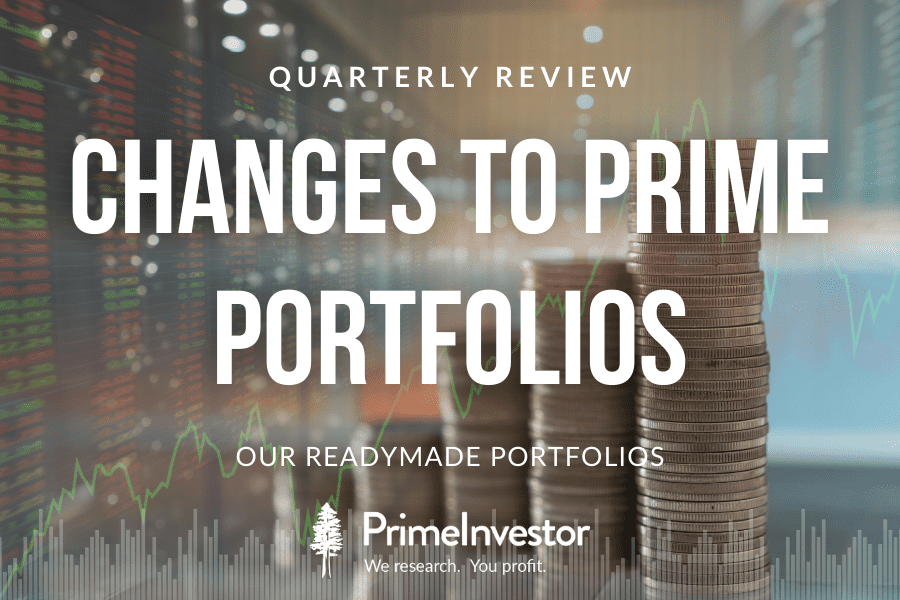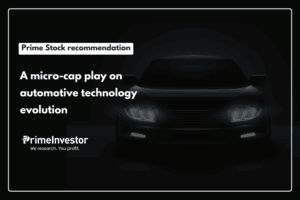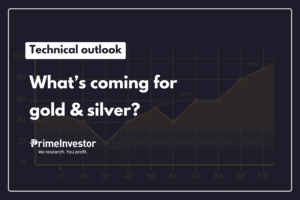Prime Portfolios are a set of 19 unique portfolios that meet over 30 different investor timeframes and needs. Prime Portfolios are listed under Ready-to-use-portfolios in the Recommendations menu dropdown. These portfolios primarily use mutual funds, but where there are better-suited products such as deposits or government schemes, the portfolios include those too.
We review these portfolios every quarter, along with our other recommendations. We make changes to the portfolios to remove underperformers or to include any new investment opportunity or product that may come by.

In this quarter’s review, we have made the following changes to some of the portfolios:
- Replaced underperforming funds in some portfolios with newer ones
- Given exit & reinvest recommendations on funds that were earlier part of the portfolios. Our intention is to tighten the portfolio to make sure your returns aren’t weighed down by funds that remain subdued performers. Please note that capital gains tax may be applicable on these exits.
Our suggestion is that you implement these changes as early as you can, though you are free to decide when you wish to make the exits.
As always, we start with an explainer of Prime Portfolios and how to use these, for the benefit of our newer customers. If you’re already an old hand – well, skip right on to the section that interests you in the table of contents below!
Construction of Prime Portfolios
We have classified Prime Portfolios based on popular financial needs/goals you may have. The basis for many of these would be the goal’s timeframe. We have therefore segregated many of these goals further into timeframe buckets. For those looking for passive investing options, check the Odds and Ends portfolios.
Fund or instrument selection: Prime Portfolios draw from Prime Funds and mix funds with different strategies to minimize duplication within a portfolio. However, there may be a few cases where funds are outside of Prime Funds. This apart, we use other products, primarily on the fixed income side, in portfolios where they will be good options.
Asset allocation: The asset allocation in Prime Portfolios is done based on the ‘ideal’ allocation for a given timeframe, or a given goal. But this is not cast in stone. Assess your own capacity to take risk before choosing a portfolio. These portfolios are not ‘advisory’ in nature. They are bundled MF products with a mix of equity and debt funds and fixed income options with varying strategies for diversification.
Using Prime Portfolios
Prime Portfolios are useful in the following cases:
- If you are new to mutual fund investing, or don’t know how to mix funds and want a readymade basket of funds to invest in
- If you are an existing investor but have new goals and want an asset-allocated portfolio for that purpose
- If you wish to build your own portfolio by taking cues from the asset allocation and category allocation that we use
- If you wish to add or modify your existing portfolios by taking cues from Prime Portfolios’ construction using Prime Funds or MF review tool. You can read this article on building your own portfolio.
If you’re investing in or referring to any Prime Portfolio, note the following:
- We review these portfolios every quarter after the review of our ratings, recommendations, and Prime Funds. So, this will typically be 2-3 weeks after the end of a quarter.
- In the review, where we make changes, we will explicitly specify whether a fund needs to be exited (sold) or only SIPs should be stopped and investments made so far held. Changes may involve fund changes or individual fund allocation changes.
- In our review reports, we mention only those portfolios where there are actual changes or portfolios to which we wish to draw your attention on any performance. If a Prime Portfolio is not mentioned in these reports, you can assume that there are no changes.
- If you wish to track changes to a portfolio, please click the ‘Follow’ button to ensure you receive alerts about the changes. Your Dashboard will also show you portfolios that have been changed when you Follow a portfolio.
- We send email and Dashboard alerts on changes only for those who ‘Follow’ a portfolio. However, we also publish a report on the blog on the same every quarter, with the detailed reasoning for changes along with action to be taken. Either way, keep note of our emails – at least at the end of every quarter 😊
- Some asset classes in your portfolio may have strayed from the original asset allocation as market rallies. This is something only you need to run a check on (as each of you would have invested in different times), once a year, to see whether you need to rebalance. The rebalancing concept is explained in detail in this article on rebalancing, and we have built a calculator to tell you how much to invest/redeem in rebalancing.
- We review and publish a report on portfolio performance since inception at the end of every calendar year.
Essentially, it is important for you to read and record our emails for all of the above. So kindly make sure you find some time to do this to keep your portfolio in good shape!
Changes made to Prime Portfolios
In this quarter, we have made fund additions/removals from some portfolios besides focusing on removing other overhangs in some portfolios. The portfolios with changes, action and reasoning are listed below.
3-5 year portfolio
In this portfolio, we are not making any fund changes to the current portfolio. However, we are issuing an exit recommendation on the units in Franklin India Corporate Debt that earlier investors would have held. We had stopped recommending the fund in our June 2020 review. The reasons are as follows:
- We had removed the fund in our April 2020 review and replaced it with HDFC Corporate Bond. This removal was due to a rise in potential risk as holdings got more concentrated towards individual corporate groups besides exposure to higher-risk papers within the mandate of the corporate bond category.
- Over the past two years, the fund has lagged HDFC Corporate Bond fairly consistently on 1-year returns. At times, the underperformance has been stark at about 2 percentage points. Therefore, continuing to hold the fund in the portfolio can dampen overall returns.
Therefore, all investments made in Franklin India Corporate Debt can be exited.Reinvest this amount in HDFC Corporate Bond. You may have to pay capital gains tax on this amount.
If you do not hold Franklin Corporate Debt - since you may have begun investing after we made those changes – there is no action needed in this review. There are no other changes we are making to the portfolio. The portfolio continues to have ICICI Pru Equity & Debt, which we had removed in our July 2020 review owing to its underperformance then. The fund has since smartly recovered and is delivering well for the portfolio.
5-7 year portfolio
In this portfolio, we are making two levels of changes. One, fund changes in the existing portfolio. Two, exit recommendations on funds that were earlier part of the portfolio.
Current portfolio changes: In this review, we are removing Kotak Flexicap. For the past few quarters, we have been tracking its underperformance compared to the Nifty 500 TRI. Given its strong past record, value bias, and large-cap bent, we allowed the fund some lag in performance compared to more aggressive peers. The fund also appeared to be narrowing the gap by which it was trailing both the Nifty 500 and the Nifty 200 indices last year. That, however, seems to have fizzled out. Therefore, to avoid further pressure on portfolio returns, we are removing the fund. Continue to hold all investments made, but stop SIPs.
In its place, we are adding a simple UTI Nifty Index fund. The Nifty 50 index is a formidable one to beat. It offers the portfolio the large-cap exposure it needs and will keep returns in line with the market, allowing the other more aggressive funds to deliver returns. You can start SIPs in this fund instead.
Exit recommendations: We are recommending an exit from two funds that were earlier part of this portfolio. The first is Invesco India Growth Opportunities, which we replaced in our April 2021 review. The fund continues to be behind the benchmark Nifty LargeMid 250. Its recent performance shows that it has reduced the extent of underperformance.
However, the fund has exhibited signs of recovery earlier as well, only to slip back. This apart, we had included it as an aggressive performer to improve portfolio returns. Its current performance does not fulfil this role and is therefore better exited.
The second fund is Franklin India Prima, which we replaced in our April 2020 review. This mid-cap fund was one that helped contain downsides very well and was a stable performer. However, it has been trailing the Nifty Midcap 150 TRI index over the past two years. Unlike DSP Midcap, which also scores on its low volatility and downside containment, the fund has not narrowed its underperformance.
If you hold either or both these funds in your Prime portfolio, exit them fully. Reinvest in Motilal Oswal Nifty Midcap 150.
Above 7 years portfolio
In this review, we have not made any changes to the funds in the current portfolio. However, we are recommending an exit from Invesco India Growth Opportunities, which was earlier part of this portfolio. We had replaced the fund in our April 2021 review.
The fund continues to be behind the benchmark Nifty LargeMid 250. Its recent performance shows that it has reduced the extent of underperformance. However, the fund has exhibited signs of recovery earlier as well, only to slip back. This underperformance is therefore weighing on overall returns, even though the overall allocation is not high. We are therefore consolidating the portfolio with this change.
If you do not hold this fund – i.e., if you had entered after we stopped recommending the fund in the portfolio – you need not make any changes in this review.
High-growth portfolio
In this portfolio, we are making two levels of changes. One, fund changes in the existing portfolio. Two, exit recommendations on funds that were earlier part of the portfolio.
Current portfolio changes: In this review we have a couple of changes. We are removing ICICI Pru Nifty Next 50 Fund. This fund continues to be part of Prime Funds. However, we are making a change in order to bring in a broader market-cap-based index in this portfolio, in line with the high-growth strategy. This will help boost performance and indirectly introduce a higher midcap component to the portfolio.
Accordingly, the index fund we are adding is the Motilal Oswal Nifty 500 index fund. This index is a broad market-cap-based index representing over 96% of the free float market cap in the listed space with holdings across large mid and small-cap stocks. You can stop SIPs in ICICI Pru Nifty Next 50 index fund and start in Motilal OSwal Nifty 500 index fund. Continue to hold existing investments in the Nifty Next 50 fund.
The international fund Motilal Oswal Nasdaq 100 FoF does not accept fresh investments at present, owing to RBI restrictions. We were expecting the restriction to be relaxed in a short while. Since that is yet to happen, we are introducing Kotak Nasdaq 100 FoF in its place. Since this fund invests in an international Nasdaq 100 ETF - iShares Nasdaq 100 UCITS ETF, it is not subject to the same restrictions for now. Continue to hold the Motilal fund. You can start fresh SIPs in the Kotak Nasdaq 100 FoF.
Otherwise, you can also choose to wait for the restriction to be removed on international funds and restart SIPs in the Motilal fund at that time if you wish to avoid holding too many funds.
Exit recommendations: We are recommending an exit from two funds that were earlier part of this portfolio. The first is HDFC Smallcap, which we removed and gave a stop-SIP recommendation in March 2020, owing growing size and underperformance. Exit this fund and reinvest the amount in the portfolio’s current smallcap fund Axis Smallcap.
The second fund we are suggesting an exit in Franklin India Corporate Debt. We have given a detailed reason for this in the section ‘3-5 year portfolio’ above. Please refer to the same. The proceeds from the sale of this fund can be reinvested in the current debt fund in the portfolio, HDFC Corporate Bond.
If you do not hold either of these funds, you need not make any changes except for those explained in ‘Current portfolio changes’ section above.
NRI Active Portfolio
In this review, we have not made any changes to current portfolio funds. However, we are recommending an exit from Invesco India Growth Opportunities, which was earlier part of this portfolio. We had replaced the fund in our April 2021 review.
The fund continues to be behind the benchmark Nifty LargeMid 250. Its recent performance shows that it has reduced the extent of underperformance. However, the fund has exhibited signs of recovery earlier as well, only to slip back. This underperformance is therefore weighing on overall returns, even though the overall allocation is not high. Reinvest this amount in Kotak Emerging Equity. If you do not hold the Invesco fund, there is no action that you need to take in this review.
US/Canada NRI Portfolio
In this review, we have not made any changes to current portfolio funds. However, we are recommending an exit from L&T Midcap. We had replaced the fund in our April 2021 review. This fund has been an underperformer in the category, and we held it to see if there is any improvement. However, continued underperformance coupled with the AMC being taken over by HSBC AMC has led us to take the call of exiting this fund and consolidate the portfolio.
Invest the sale proceeds into Nippon India Smallcap, which is part of the current portfolio. Those who did not hold L&T Midcap fund don’t need to act on this change. There is no other change in this portfolio, in this review.
Passive Investing - index fund portfolio
In this review, we have just one change to this portfolio. The international fund Motilal Oswal Nasdaq 100 FoF does not accept fresh investments at present, owing to RBI restrictions. We were expecting the restriction to be relaxed in a short while. Since that is yet to happen, we are introducing Kotak Nasdaq 100 FoF in its place. Since this fund invests in an international Nasdaq 100 ETF - iShares Nasdaq 100 UCITS ETF, it is not subject to the same restrictions for now.
Continue to hold the Motilal fund. You can start fresh SIPs in the Kotak Nasdaq 100 FoF. Otherwise, you can also choose to wait for the restriction to be removed on international funds and restart SIPs in the Motilal fund at that time if you wish to avoid holding too many funds.
Passive Investing - ETF portfolio
In this review, we have not made any changes to any ETF. However, we’d like to highlight the Motilal Oswal Nasdaq 100 ETF. Owing to curbs on overseas investments that the Reserve Bank has put in place for the mutual fund industry, this ETF is unable to accept investments to create fresh units. As a result, the ETF will not be able to ensure a demand-supply match for the ETF during trading. This can cause differentials between the ETF’s traded market price and underlying NAV.
So far, we have noticed a marked deviation only on a few days. However, until such time that the RBI raises the overseas investment limit, you need to be aware of a higher tracking error in this ETF. You can choose to wait to invest in this ETF if the risk of tracking error bothers you.






13 thoughts on “Quarterly review: Changes to Prime Portfolios, our readymade portfolios”
Just wanted to point out one thing. Amit Ganatra. The previously successful fund manager of Invesco Contra, has come back to Invesco fold & now lead managing Invesco Growth Oppty fund. Amit went to HDFC AMC and came back (rather surprisingly). May be wait for a three to four Quarters on Invesco Growth Oppty fund & take a decision later.. is what I am saying to myself.
Sure, you can choose to wait to see if performance picks up. We give calls based on the extent & length of underperformance and the impact it has on the portfolio overall. – thanks, Bhavana
Mid-cap index funds barely have a 3-year track record. Many active funds continue to beat them by a good margin. Considering these two aspects, is it not better to invest in a fund like Axis Mid-cap?
Midcap index funds don’t have a long record, but the index itself has been around for years. So it’s possible to understand its behaviour. Not all mid-cap funds find it easy to beat the index. We’ve mixed an active and a passive fund to get different opportunities, depending on the portfolio. – thanks, Bhavana
I get a feeling that constantly chasing a fund name, exiting and churning portfolios with new names, and paying for this cost of change through LTCG, the opportunity cost of doing so etc., eventually catches up with law of averages of staying put with a good fund uouse and name, the cycle is perpetual. In my case, i entered into Invesco Growth and Kotak Flexicap for the first time about 2 years back, my old and stable funds have caughtup with averages. The maturity of index/etf investing is still evolving in India, is it time to believe that generating alpha over the next decade is going to be challenging, construct a long term passive portfolio and forget it. I am struggling to quantify the cost of change to portfolio recommendations, considering the LTCG impact. I understand predicting the future is impossible, but these recommendations are also backwars looking. I am confused.
Depends on the funds you have and how many years you are investing…leaving a current poor performer can eventually catch up later if the fund manages. Or, it could remain poor and never recover. If that’s something you’re willing to risk, then you can avoid exiting underperformers. In this case, you can choose to hold on to whichever fund we’re recommending an exit from, or exit at a later date when you may need to rebalance or need to liquidate your investments to meet any expense.
We don’t churn portfolios unless we see that the performance really drags overall returns or is too steep to make up. We go by the fund’s portfolios and changes too, when we take these hold/sell calls. Otherwise, as you mentioned, you can simply just use index funds – and there are a growing variety of these – and create a portfolio that requires very low maintenance. We’ve discussed it here: https://www.primeinvestor.in/how-to-build-a-permanent-portfolio/ – thanks, Bhavana
How about NAVI NASDAQ 100 with a lower TER instead of the Kotak one?
You can replace, if you wish to. However, please note that expense ratios can change. – thanks, Bhavana
I can see there is slow introduction of passive funds in prime portfolio and replacing active funds. Is this trend going to continue as active funds struggle to beat market returns. There are more number of direct plan portals started recommending index funds predominately for equity side than active funds. Is it sign of passive picking up in indian retail investors interest of choice.
Yes, passive options are picking up in our markets. We include passive where we don’t find good active funds. We’re not writing off active funds altogether 🙂 – thanks, Bhavana
Dear Prime Investor team,
10 days back you guys shooted an article asking passive investors to buy ICICI PRU Nifty next 50 index fund, now you suggesting to hold the fund in this review. I followed your suggestion. I switched from ICICI blue chip fund to next 50 index funds. What should I do now.?? Kindly advise.
The shift away from IPru Nifty Next 50 is specifically for this portfolio only, to give a broader market exposure, add mid-cap/small-cap since its an aggressive portfolio. As mentioned in the report, the Next 50 remains part of Prime Funds and you can retain your investments in it. However, please note that it is not a large-cap substitute; it is higher returning-higher risk and listed under Equity Aggressive in Prime Funds. – thanks, Bhavana
Thanks Bhavana. Appreciate your prompt reply and inputs.
Comments are closed.